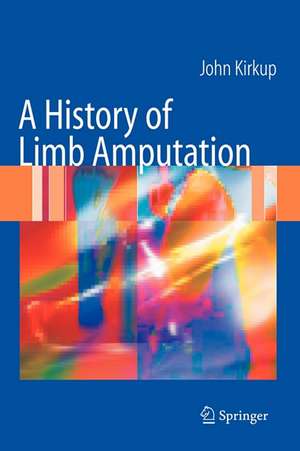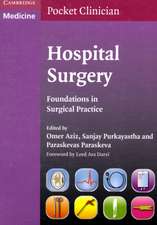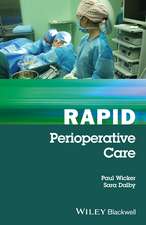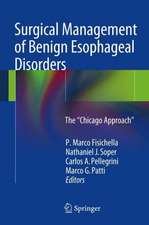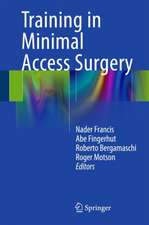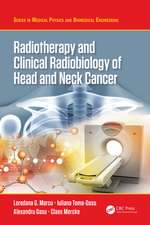A History of Limb Amputation
Autor John R. Kirkupen Limba Engleză Hardback – 19 dec 2006
| Toate formatele și edițiile | Preț | Express |
|---|---|---|
| Paperback (1) | 1652.90 lei 6-8 săpt. | |
| SPRINGER LONDON – 12 oct 2010 | 1652.90 lei 6-8 săpt. | |
| Hardback (1) | 1662.20 lei 6-8 săpt. | |
| SPRINGER LONDON – 19 dec 2006 | 1662.20 lei 6-8 săpt. |
Preț: 1662.20 lei
Preț vechi: 1749.69 lei
-5% Nou
Puncte Express: 2493
Preț estimativ în valută:
318.10€ • 328.17$ • 269.23£
318.10€ • 328.17$ • 269.23£
Carte tipărită la comandă
Livrare economică 05-19 martie
Preluare comenzi: 021 569.72.76
Specificații
ISBN-13: 9781846284434
ISBN-10: 1846284430
Pagini: 184
Ilustrații: VIII, 184 p. 99 illus.
Dimensiuni: 178 x 254 x 13 mm
Greutate: 0.58 kg
Ediția:2007
Editura: SPRINGER LONDON
Colecția Springer
Locul publicării:London, United Kingdom
ISBN-10: 1846284430
Pagini: 184
Ilustrații: VIII, 184 p. 99 illus.
Dimensiuni: 178 x 254 x 13 mm
Greutate: 0.58 kg
Ediția:2007
Editura: SPRINGER LONDON
Colecția Springer
Locul publicării:London, United Kingdom
Public țintă
Professional/practitionerDescriere
First part of the book presents a unique and coherent study of natural amputations due to congenital absence, disease, frostbite, toxins, domestic and wild animal trauma, and non-medical reasons related to punitive, ritual and legal decisions. Following the introduction of gun powder in the 15th century, surgical action became significant. The subsequent development of surgical amputation and its difficulties form a major part of the book, summarising the evolution of the control of haemorrhage and infection, pain relief, techniques, instrumentation, complications, prostheses, results and case histories. In addition, alternative procedures, increasingly important in the last two centuries, are debated and factors associated with self-amputation in extremis, not as rare according to press reports, are also examined.
This richly illustrated book will be of interest to medical and social historians, surgeons, limb-fitting surgeons and prosthetists, anaesthetists, limb manufacturers, social historians, ethnologists and amputees.
This richly illustrated book will be of interest to medical and social historians, surgeons, limb-fitting surgeons and prosthetists, anaesthetists, limb manufacturers, social historians, ethnologists and amputees.
Cuprins
and Sources.- Natural Causes of Dismemberment.- Accidental Causes for Amputation: Auto-Amputation.- Ritual, Punitive, Legal and Iatrogenic Causes.- Cold Steel and Gunshot Causes.- Elective Amputation: Early Evolution to the End of the 17th Century.- Elective Amputation: From the 18th Century to 1846.- Elective Amputation: From 1846 to Recent Times.- Interpretations of Amputation by Society, Patients and Surgeons.- Surgical Instrumentation and Equipment.- Indications, Timing and Procedures.- Stumps: Reattachment,Management, Complications, Revision and Care for Limb-Fitting.- Artificial Limbs and Rehabilitation.
Recenzii
From the reviews:
“After a description of the more common causes for amputation of the limbs, the author analyses more extensively the different causes:–trauma cases of various etiologies,–ritual, punitive, legal amputation,–iatrogenic causes,–war amputations. … A very uncommon book … bringing some interesting overview along the history of surgery.” (Jean-Yves Jenny, European Journal of Orthopaedic Surgery & Traumatology, Vol. 21, 2011)
“This is a well written and beautifully illustrated history of amputation, describing the causes and techniques of amputation, and ending with more recent developments in rehabilitation and prosthetics. … the book should be seen as a fascinating insight into how surgical and anaesthetic techniques, and operative instruments, have developed over the centuries. … Surgeons and physicians from a variety of different specialties, and anyone with an interest in medical history, will enjoy it.” (I. Loftus, British Journal of Surgery, Vol. 95, October, 2008)
“The author has provided a thoroughly researched history of human limb amputation from prehistory to the present from both a patient’s and a physician’s perspective. … ‘The author’s goals are worthwhile because there is no similar book that provides specific information on amputation, a topic of major concern while we are engaged in war. … The author has broadly and carefully treated an unattractive subject with professional detachment, patient empathy, and a concern for the level of societal acceptance.” (Ralph D. Arcari, National Taiwan University Library, August, 2007)
“A History of Limb Amputation is a work of scholarship and comes from the pen of an erudite writer. … the most elevating theme in Kirkup’s book is the strength of the human spirit, for so many cases of amputation are related without any form of anaesthetic, in which the patient exhibited extraordinary calm and patience. … In short this book should be bought and read by all aspirants to medicine. Law Lords and NHS managers would also come to no harm from reading it.” (R. Birch, The Journal of Bone and Joint Surgery, Vol. 90 (18), October, 2008)
“After a description of the more common causes for amputation of the limbs, the author analyses more extensively the different causes:–trauma cases of various etiologies,–ritual, punitive, legal amputation,–iatrogenic causes,–war amputations. … A very uncommon book … bringing some interesting overview along the history of surgery.” (Jean-Yves Jenny, European Journal of Orthopaedic Surgery & Traumatology, Vol. 21, 2011)
“This is a well written and beautifully illustrated history of amputation, describing the causes and techniques of amputation, and ending with more recent developments in rehabilitation and prosthetics. … the book should be seen as a fascinating insight into how surgical and anaesthetic techniques, and operative instruments, have developed over the centuries. … Surgeons and physicians from a variety of different specialties, and anyone with an interest in medical history, will enjoy it.” (I. Loftus, British Journal of Surgery, Vol. 95, October, 2008)
“The author has provided a thoroughly researched history of human limb amputation from prehistory to the present from both a patient’s and a physician’s perspective. … ‘The author’s goals are worthwhile because there is no similar book that provides specific information on amputation, a topic of major concern while we are engaged in war. … The author has broadly and carefully treated an unattractive subject with professional detachment, patient empathy, and a concern for the level of societal acceptance.” (Ralph D. Arcari, National Taiwan University Library, August, 2007)
“A History of Limb Amputation is a work of scholarship and comes from the pen of an erudite writer. … the most elevating theme in Kirkup’s book is the strength of the human spirit, for so many cases of amputation are related without any form of anaesthetic, in which the patient exhibited extraordinary calm and patience. … In short this book should be bought and read by all aspirants to medicine. Law Lords and NHS managers would also come to no harm from reading it.” (R. Birch, The Journal of Bone and Joint Surgery, Vol. 90 (18), October, 2008)
Notă biografică
John Kirkup, MD, MA, FRCS, Dip Hist Med studied at Emmanuel College, Cambridge and St Mary’s Hospital, London, qualifying in 1952. After service in the Royal Navy he worked as an orthopedic surgeon for the Bath Clinical Area, Somerset, introducing ankle joint replacement to the United Kingdom in 1976.
Always intrigued by the evolution of surgery from its pre-historic roots, Mr Kirkup edited facsimiles of Wiseman’s Of Wounds (1676) and Woodall’s Surgions Mate (1617), published A Historical Guide to British Orthopaedic Surgery, and contributed chapters in books on Ambroise Paré, on pain management during surgery, on trepanation, on the battle against infection, on damaged surgeon’s equipment of the Mary Rose shipwreck and on instrumentation generally. He published a wide variety of journal communications including and extended series on surgical instruments and on the history of foot and ankle surgery, and twelve surgical entries in the New Dictionary of National Biography. He has been Hunterian, Vicary, Sydenham and Hamilton Russell Lecturer, was awarded the Sir Arthur Keith Medal of the Royal College of Surgeons of England, and has advised widely on museum collections, especially in the UK, Portugal and Australia.
Formerly President of the British Society for Medical History, President of the History Section of the Royal Society of Medicine, Honorary Archivist of the British Orthopaedic Association and Chairman of the Historical Medical Equipment Society, Mr Kirkup is currently Honorary Curator of the Historical Instrument Collection at the Royal College of Surgeons, London, and Lecture in Surgical History to the Society of Apothecaries, London. He is also about to publish a book on the evolution of surgical instruments.
Always intrigued by the evolution of surgery from its pre-historic roots, Mr Kirkup edited facsimiles of Wiseman’s Of Wounds (1676) and Woodall’s Surgions Mate (1617), published A Historical Guide to British Orthopaedic Surgery, and contributed chapters in books on Ambroise Paré, on pain management during surgery, on trepanation, on the battle against infection, on damaged surgeon’s equipment of the Mary Rose shipwreck and on instrumentation generally. He published a wide variety of journal communications including and extended series on surgical instruments and on the history of foot and ankle surgery, and twelve surgical entries in the New Dictionary of National Biography. He has been Hunterian, Vicary, Sydenham and Hamilton Russell Lecturer, was awarded the Sir Arthur Keith Medal of the Royal College of Surgeons of England, and has advised widely on museum collections, especially in the UK, Portugal and Australia.
Formerly President of the British Society for Medical History, President of the History Section of the Royal Society of Medicine, Honorary Archivist of the British Orthopaedic Association and Chairman of the Historical Medical Equipment Society, Mr Kirkup is currently Honorary Curator of the Historical Instrument Collection at the Royal College of Surgeons, London, and Lecture in Surgical History to the Society of Apothecaries, London. He is also about to publish a book on the evolution of surgical instruments.
Textul de pe ultima copertă
A History of Limb Amputation traces humanity’s long experience of natural amputations due to congenital absence, disease, frostbite, toxins, domestic and wild animal trauma, and for non-medical reasons related to punitive, ritual, and legal actions, ultimately leading to the development of elective surgical amputation.
While the evolution of surgical techniques forms a major chapter in the book, many ancillary problems are addressed including the control of hemorrhage and infection, the approach to pain relief, the development of suitable instruments and equipment, and the invention of prostheses, all suitably illuminated with case histories and relevant illustrations. In addition, alternative procedures designed to avoid amputation, increasingly important in the last two centuries, are debated, and factors associated with self-amputation in extremis, not rare according to press reports, are also examined. A separate chapter considers the philosophy and interpretations of society, patients, and surgeons faced with amputation, particularly before anesthesia.
The book will be of interest to medical and social historians, surgeons, and nurses undertaking amputations, limb-fitting surgeons and prosthetists, limb manufacturers, and amputees themselves.
While the evolution of surgical techniques forms a major chapter in the book, many ancillary problems are addressed including the control of hemorrhage and infection, the approach to pain relief, the development of suitable instruments and equipment, and the invention of prostheses, all suitably illuminated with case histories and relevant illustrations. In addition, alternative procedures designed to avoid amputation, increasingly important in the last two centuries, are debated, and factors associated with self-amputation in extremis, not rare according to press reports, are also examined. A separate chapter considers the philosophy and interpretations of society, patients, and surgeons faced with amputation, particularly before anesthesia.
The book will be of interest to medical and social historians, surgeons, and nurses undertaking amputations, limb-fitting surgeons and prosthetists, limb manufacturers, and amputees themselves.
Caracteristici
A comprehensive study of the evolution of amputation from the remote past to the present
Highlights the long preamble of natural, accidental, tribal and punitive dismembering, as a prelude to surgical amputations
Includes auto-amputation (by trapped patients themselves), not uncommon even today
Debates the interacting philosophy, religious beliefs and concepts of society, patients and surgeons
Includes supplementary material: sn.pub/extras
Highlights the long preamble of natural, accidental, tribal and punitive dismembering, as a prelude to surgical amputations
Includes auto-amputation (by trapped patients themselves), not uncommon even today
Debates the interacting philosophy, religious beliefs and concepts of society, patients and surgeons
Includes supplementary material: sn.pub/extras
